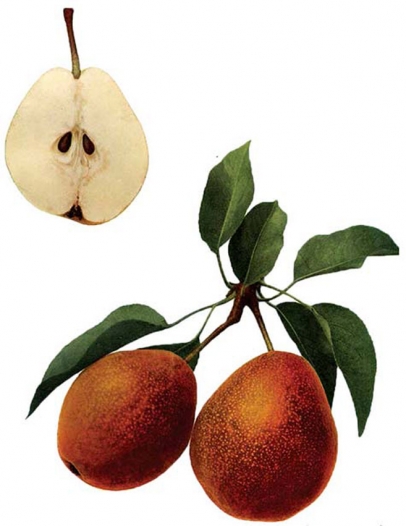In the Garden: Key to Tasty Kieffer Pears: Chillin’
Old farm sites that have long been abandoned frequently reveal their past life in an oddly placed clump of daffodils or a lonely old orchard. Home orchards are one part of a once-thriving agricultural model that fed the family, and their most enduring member is the Kieffer pear.
The Kieffer pear still stands when nothing else does and has always been a beacon that a farmhouse and family lived on the land at one time.
The Kieffer pear has been around since the 1870s, resulting from a natural cross between an Asian sand pear and a European Bartlett at Peter Kieffer’s fruit nursery outside of Philadelphia. It has a crisp texture like an apple and was used in canning.
But what many don’t realize is that it was also exalted for being a great storage pear for fresh eating straight from the root cellar. It seems we have forgotten how to treat it as an eating pear, because I mostly hear and read comments like “the Kieffer pear is not an eating pear” or even worse the “it is terrible and grainy and hard!” This simply is not true if you treat the pear properly.
If you have ever happened upon an old tree and plucked a pear from its heavy branches you were likely put off by the hard fruit. You see, there is virtue in this hard fruit if you can’t go to the grocery store every few days: the Kieffer pear stores and ripens after an initial chilling period so this is perfect if you want pears in the root cellar to last through the winter! There is no instant gratification with the Kieffer; this is traded for future food security instead.
In fact, there is a category of pears called “winter pears” because this chilling period initiates the ripening process and is one of the reasons pears are typically harvested prior to true ripe on the tree.
Usually if pears are left on the tree to ripen their skin gets tough and the flesh gets mealy. The one exception to “pears ripen best off the tree” are Asian pear varieties like Hosui, Chojuro and Shinseiki. Asian pears are also an excellent choice for the home orchard. So, back to the Kieffer pear, in our Fruit, Nut and Berry Inventory book the Kieffer pear is described as “large, long, golden yellow fruit with a crimson blush. Crisp, juicy, coarse textured, white flesh with musky aroma. Excellent for canning and baking.
Good variety for pear honey and preserves. Pick fruit while still hard and store in a cool place; reaches peak flavor when fruit gives slightly to the touch. Hardy, vigorous tree bears young; dependable crops. Self-fruitful. Practically immune to blight. Tolerates hot climates; grows well in all parts of the country. Extra hardy.
Ripens from mid-September to mid-October. Requires 350 hours of chilling…” A Kieffer pear tree requires a few things — all of which we can deliver in Kentuckiana. They like slightly acid soil that is well drained. They perform well in the range of 350–400 chill hours, which refers to the time the tree experiences temperatures below 45°. A restful dormant period for the tree under 45° means good bud break, bloom and fruiting.
The Kieffer pear also blooms a little later in the spring, which means it rarely gets hit by a killing frost or freeze. They do not need another tree for cross-pollination like many other pears but it will increase yields if you have more than one pear tree. A healthy bee population is in order here, too, to move the pollen from flower to flower.
So if you are not yet sold on the virtues of this old tree, what will convince you? I am afraid the tree fell out of favor because of the changing ways we sourced our food. No longer was the home orchard providing fruit for our families directly or through the corner market that was frequented; the supermarket became our source for fruit, which meant a bulk proposition sourced from a monoculture orchard growing fruit ready to eat, not ready to store.
For fear of losing the food knowledge that allows us to enjoy the Kieffer pear instead of thinking it tastes terrible, remember the chill. And if you come across a Kieffer pear tree out standing in the middle of a field somewhere in October, you will know to harvest the fruit that releases with a gentle tug. You will know to store it in the produce drawer of your refrigerator and forget about it for a couple of weeks. And, you will be delighted by the pear after it has a chance to fully ripen and there will be no need to gobble them up because you will also know that they have a very long storage life.
PEAR PRESERVES
Ingredients
- 2 pounds pears
- 3 cups water
- 3 cups sugar
- 1 lemon, sliced thin
Instructions
- Pears should be hard, but ripe for preserving. The Kiefer (sic) should be stored in a cool, dry place from 3 to 5 weeks before using. Pare, core and cut fruit as desired.
- Add ½ of the sugar to the water. Boil 2 minutes.
- Add pears and boil 15 minutes. Add remaining sugar and lemon (orange may be used instead of lemon.) A piece of ginger root may also be added. Cook until fruit is tender and clear. Let stand several hours.
- Pack cold fruit into hot BALL Jars. Boil sirup (sic) until thick as honey. Pour hot sirup over pears; seal at once. (note: Today the USDA recommends a 10-minute hot water bath after jars are filled.)
Jeneen Wiche grows fruit and Kentucky-grazed poultry, eggs and lamb in Shelby County. See more at Swallow Rail Farm.




